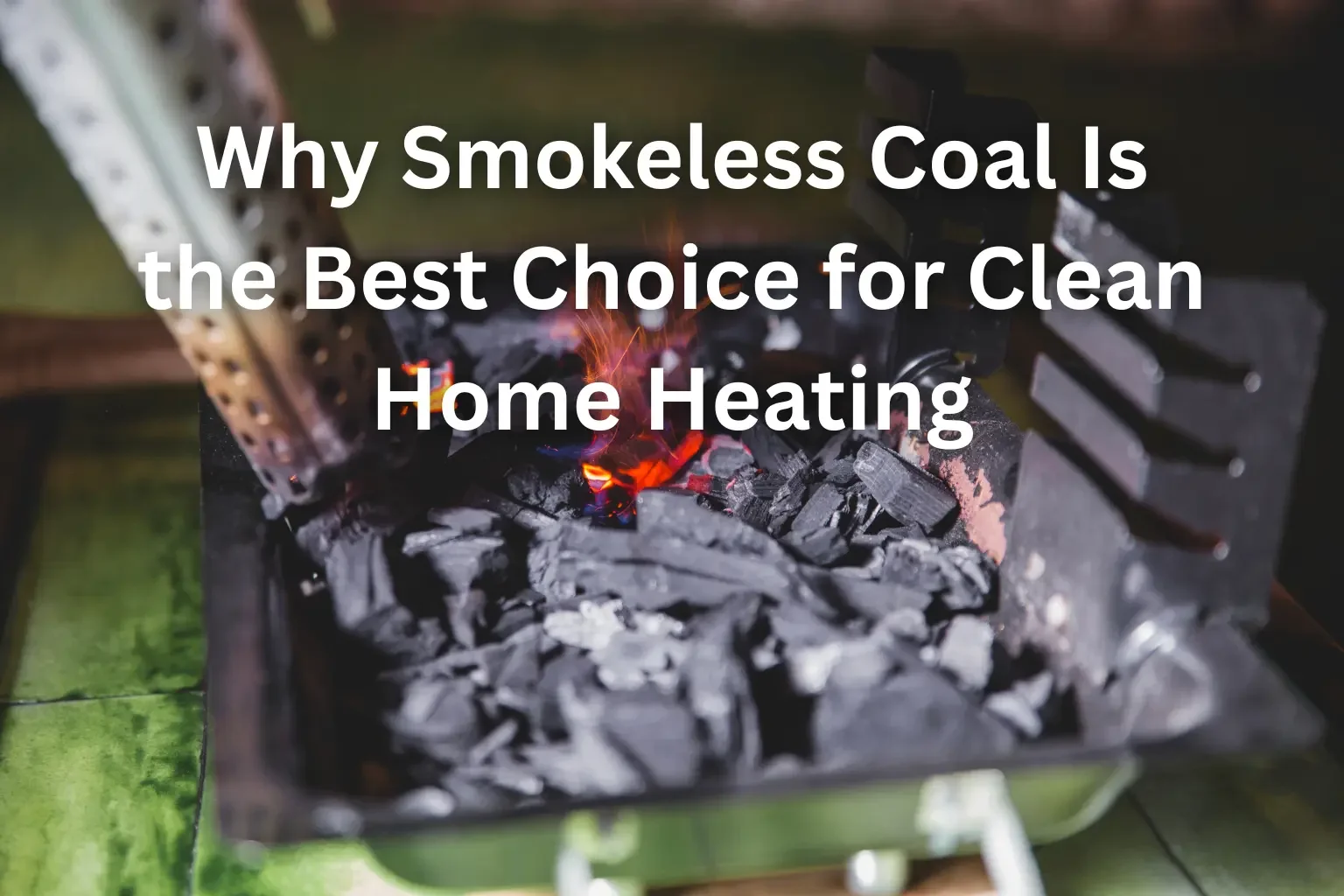Why Smokeless Coal Is the Best Choice for Clean Home Heating
As energy prices fluctuate and environmental awareness grows, homeowners across the UK are searching for efficient, sustainable, and affordable heating solutions. Among various options, smokeless coal has emerged as a top choice for those who value warmth, cleanliness, and energy efficiency. Whether you use an open fire, a multi-fuel stove, or a boiler, this modern fuel delivers excellent performance without the environmental drawbacks of traditional coal.
What Is Smokeless Coal?
Smokeless coal is a refined, low-emission fuel designed to burn more efficiently and produce minimal smoke compared to traditional house coal. It’s made by processing natural coal or other carbon-based materials under high pressure and temperature, creating compact briquettes that burn cleaner and hotter.
Unlike traditional coal, which releases visible smoke and harmful particulates, smokeless varieties comply with the UK’s Clean Air Act regulations. This means they can be safely used in smoke control areas, making them ideal for urban and suburban homes.
Environmental Benefits of Smokeless Coal
One of the primary reasons homeowners are switching to smokeless coal is its environmental friendliness. With air quality becoming a growing concern, especially in cities, smokeless fuel plays an essential role in reducing pollution.
Here’s how it helps:
Lower Emissions: Smokeless coal emits significantly less carbon dioxide, sulfur dioxide, and particulates than traditional coal.
Reduced Smoke Output: Its cleaner burn minimizes visible smoke, keeping chimneys, walls, and air cleaner.
Improved Efficiency: Because it burns hotter and longer, you need less fuel to achieve the same level of heat.
Compliance with Clean Air Regulations: It’s fully approved for use in UK smoke control zones, making it a sustainable option for environmentally conscious households.
By choosing smokeless options, homeowners contribute to cleaner air and a healthier environment, aligning with the UK’s long-term goals for reducing carbon emissions.
Economic Advantages of Using Smokeless Coal
Beyond its environmental appeal, smokeless coal offers excellent economic benefits. Many people assume that cleaner fuels come with a higher price tag, but this isn’t always the case.
Here’s why it’s cost-effective:
Longer Burn Time: Smokeless fuels are denser and more energy-rich, meaning they burn longer than standard coal.
Higher Heat Output: They provide consistent, high heat, allowing you to warm your home efficiently with less fuel.
Lower Maintenance Costs: Because it produces less soot and residue, it reduces chimney cleaning frequency and appliance wear.
Storage Efficiency: Compact briquettes take up less space and are easier to handle and store.
Over time, these savings add up, making smokeless fuel not only cleaner but also more economical in the long run.
Smokeless Coal vs Traditional Coal
Let’s compare the two directly to understand why smokeless coal has become the preferred modern option.
FeatureSmokeless CoalTraditional CoalSmoke EmissionsVery lowHighBurn TimeLong-lastingShorterHeat OutputHigh and consistentModerateEnvironmental ImpactCleaner and compliantPollutingChimney MaintenanceMinimalFrequentLegal in Smoke Control AreasYesNo
It’s clear that smokeless varieties outperform traditional coal in nearly every category, from efficiency to environmental responsibility.
Types of Smokeless Coal Available
When shopping for smokeless coal, you’ll find several types designed for different heating appliances. Choosing the right one ensures optimal performance and efficiency.
Ovals and Briquettes: Ideal for open fires and multi-fuel stoves. They’re easy to light and provide steady heat.
Cobs and Nuggets: Denser forms suitable for boilers and large stoves.
Ecoal: Made from renewable biomass and waste materials, offering an even greener option.
Anthracite Smokeless Coal: Naturally occurring high-grade coal known for its long-lasting and hot burn.
Each type caters to specific needs, so always check your appliance’s requirements before purchasing.
How to Use Smokeless Coal Efficiently
To get the best performance from smokeless coal, follow these practical tips:
Use a Clean Grate: Remove old ash to ensure proper airflow.
Layer Properly: Start with kindling and small pieces before adding larger briquettes.
Adjust Air Vents: Control airflow to maintain a steady flame and avoid over-burning.
Store Properly: Keep your fuel dry and covered to prevent moisture absorption.
Clean Regularly: Even though smokeless fuels produce less soot, occasional cleaning ensures safety and efficiency.
With proper care, you’ll enjoy consistent warmth and a clean burn throughout the colder months.
Why Smokeless Coal Is Ideal for Modern Homes
Modern homes demand heating solutions that are not only effective but also environmentally compliant and convenient. Smokeless coal meets all these requirements effortlessly.
Versatility: Works well in open fires, stoves, and solid-fuel boilers.
Cleaner Indoors: Produces less soot and smoke, keeping your home interior cleaner.
Comfort: Delivers a long, even burn for steady warmth all day or night.
Sustainability: Supports the shift toward cleaner fuels and lower emissions.
As more regions enforce stricter clean air regulations, the switch to smokeless options ensures homeowners remain compliant while enjoying reliable, cozy heating.
The Future of Home Heating with Smokeless Coal
The future of home heating in the UK is moving toward low-emission, high-efficiency fuels, and smokeless coal is at the forefront of this transition. With advanced production techniques and eco-conscious innovation, manufacturers continue to improve fuel quality and sustainability.
Many suppliers now offer smokeless coal blends made from recycled materials and renewable biomass, reducing reliance on traditional fossil sources. This shift aligns perfectly with government goals for carbon neutrality while keeping homes warm, efficient, and comfortable.
Frequently Asked Questions (FAQ)
1. What makes smokeless coal “smokeless”?
It’s processed to remove volatile materials that cause smoke when burned. The result is a dense, high-carbon fuel that burns cleanly with minimal emissions.
2. Can I use smokeless coal in any fireplace or stove?
Most modern multi-fuel stoves and open fires can burn smokeless fuels. However, always check your manufacturer’s guidelines before use.
3. Is smokeless coal suitable for smoke control areas?
Yes, it’s approved under the Clean Air Act, making it safe and legal to use in all UK smoke control zones.
4. How long does smokeless coal burn?
Depending on the brand and size, it can burn up to 40% longer than regular house coal, providing consistent heat for several hours.
5. Is smokeless coal more expensive than traditional coal?
While the upfront cost per bag may be slightly higher, its longer burn time and efficiency make it more cost-effective in the long run.
6. Can smokeless coal damage my chimney or stove?
No, in fact, it’s less likely to cause buildup and corrosion because it produces fewer residues and less acidic smoke.
7. How should I store smokeless coal?
Store it in a cool, dry, and covered area to prevent moisture absorption and maintain performance quality.
8. Is smokeless coal better for the environment?
Absolutely. It produces fewer emissions and particulates, helping reduce air pollution and contributing to cleaner, healthier living spaces.
Conclusion
For homeowners seeking a cleaner, more efficient, and eco-friendly heating option, smokeless coal stands out as the best choice. It combines traditional comfort with modern sustainability, offering powerful heat, reduced emissions, and excellent value for money.
As we move toward a greener future, switching to smokeless fuels isn’t just about compliance — it’s about making your home warmer, cleaner, and more responsible for generations to come.

